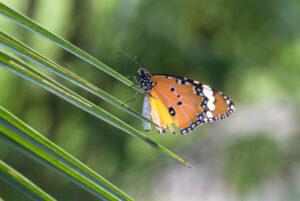Report Finds Monsanto’s Roundup Directly Responsible for Declining Monarch Butterfly Populations

According to a new report from the Center for Food Safety, the popular glyphosate-based herbicide best known as Monsanto’s Roundup, is one of the leading causes of decline in monarch butterfly populations.
Roundup is widely used on genetically engineered crops designed by Monsanto and other biotech companies. The herbicide wipes out milkweed, which serves as the sole source of food for the monarch butterfly.
And according the Center for Food Safety, this decline in monarch populations has occurred largely in the last two decades, roughly the same amount of time that genetically modified crops have been in production, using millions of pounds of glyphosate.
The future of the monarch butterfly is so uncertain that the U.S. Fish and Wildlife Service is currently reviewing data on whether the species should be listed as threatened under the Endangered Species Act.
“This report is a wake-up call. This iconic species is on the verge of extinction because of Monsanto’s Roundup Ready crop system,” Andrew Kimbrell, executive director at Center for Food Safety said in a statement. “To let the monarch butterfly die out in order to allow Monsanto to sell its signature herbicide for a few more years is simply shameful.”
According to the Center for Food Safety, the monarch butterfly population has decreased by 90 percent in the last twenty years. “This year’s population was the second lowest since careful surveys began two decades ago,” the group said on its website. “The critical driver of monarch decline is the loss of larval host plants in their main breeding habitat, the Midwestern Corn Belt. Monarchs lay eggs exclusively on plants in the milkweed family, the only food their larvae will eat.”
Like honey bees, monarch butterflies are pollinators that have long worked in tangent with our agricultural systems. However, the development of genetically modified crops and their dependence on glyphosate, has eradicated 99 percent of the milkweed in the Corn Belt since 1999. And the Center for Food Safety warns that the monarch butterfly may not be able to bounce back from such a population deficit.
“The alarming decline of monarchs is driven in large part by the massive spraying of glyphosate herbicide on genetically engineered crops, which has virtually eliminated monarch habitat in the corn and soybean fields that dominates the Midwest landscape,” said Bill Freese, Center for Food Safety science policy analyst and co-author of the report. “Glyphosate is the monarch’s enemy number one. To save this remarkable species, we must quickly boost milkweed populations and curtail the use of herbicide-resistant crop systems.”
Find Jill on Twitter @jillettinger
Related on Organic Authority
Monarch Butterfly May Be Moved to Threatened Species List
Monarch Butterfly Migrations Major Casualties of Genetically Modified Crops
Monarch Butterflies: Latest Victims of Monsanto
Butterfly image via Shutterstock

